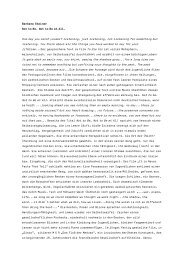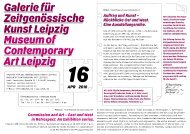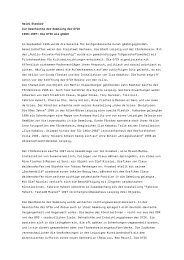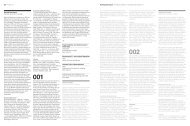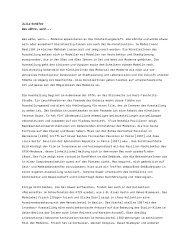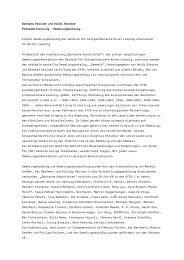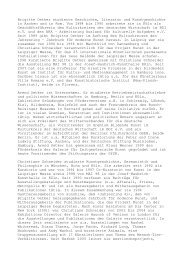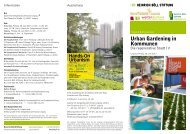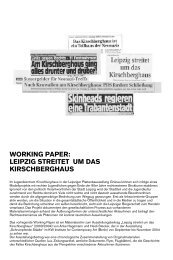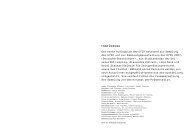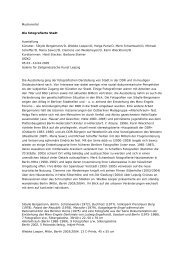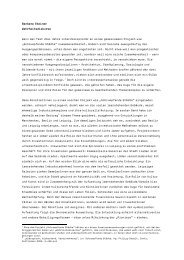Unsere Frau in Minsk: - Gfzk.de
Unsere Frau in Minsk: - Gfzk.de
Unsere Frau in Minsk: - Gfzk.de
You also want an ePaper? Increase the reach of your titles
YUMPU automatically turns print PDFs into web optimized ePapers that Google loves.
What is real life here?<br />
“What a useful th<strong>in</strong>g a map really is,” I remarked.<br />
“That is another th<strong>in</strong>g,” my Lord said, “that we learned from your country – the mak<strong>in</strong>g of maps. But<br />
we have taken the art to still greater heights. What do you th<strong>in</strong>k is the largest scale map that could<br />
really be any use?”<br />
“Someth<strong>in</strong>g like two centimetres to the kilometre, perhaps.”<br />
“Only two centimetres!” exclaimed my Lord. “We start<strong>in</strong>g us<strong>in</strong>g a scale of ten centimetres to the<br />
kilometre at a very early stage. Then we tried it with a metre. And then we got the best i<strong>de</strong>a of all: we<br />
actually succee<strong>de</strong>d <strong>in</strong> mak<strong>in</strong>g a map of the country on a scale of one to one!”<br />
“Was it used a lot?” I asked.<br />
“It hasn’t been spread out yet, so far,” my Lord replied. “The farmers were aga<strong>in</strong>st it. They said the<br />
map would cover the whole country and cut off the sun. So we are now us<strong>in</strong>g the country itself as its<br />
own map, and I do assure you, it works almost just as well.” 1<br />
It was <strong>in</strong> the w<strong>in</strong>ter of 2003 that Antje Schiffers and I were sitt<strong>in</strong>g <strong>in</strong> my kitchen, try<strong>in</strong>g to formulate<br />
the plan for a trip. We knew approximately what goal of it was to be, but not what means were to be<br />
used. My kitchen table lends itself very well to the plann<strong>in</strong>g of trips like this, because it carries on its<br />
surface a wipeable map of Europe which I stuck on it because maps are visually attractive and<br />
communicative, and can be a refresh<strong>in</strong>g stimulus to mental travels. What is more, this physical map<br />
testifies to a youth spent <strong>in</strong> West Germany, where geography lessons were characterised by this<br />
particular type of map and from which base we could float off <strong>in</strong> thought <strong>in</strong>to distant lands. The East,<br />
however, was hardly ever a factor here. Somehow it all just stayed grey, like an unknown and sleep<strong>in</strong>g<br />
giant beh<strong>in</strong>d its Iron Curta<strong>in</strong> – it rema<strong>in</strong>ed a graphic presence, <strong>in</strong> the atlas and <strong>in</strong> the media.<br />
When <strong>in</strong> 2003 we – the curators of the Leipzig Museum for Contemporary Art – set off on our first<br />
trips to the Cultural Territories, 2 the goals we aimed at were such places as Warsaw, Vilnius, Riga,<br />
Tall<strong>in</strong>n, Budapest, Prague, Brno, Zagreb, Bratislava, Ljubljana, Sofia and M<strong>in</strong>sk. Most of the places<br />
represented for me only images relayed through the media and po<strong>in</strong>ts on the physical map mentioned<br />
above, but I had never actually visited them. On my map Ljubljana was called Laibach, Zagreb was<br />
called Agram, and Bratislava, Pressburg. We travelled to some of these cities. Hardly had we arrived<br />
there when the imag<strong>in</strong>ary pictures disappeared, to be replaced <strong>in</strong> part by completely new realities (or<br />
partial realities).<br />
On this trip the wish was expressed for an ambassadress and correspon<strong>de</strong>nt who would travel as a<br />
mediator between us and the countries <strong>in</strong>volved <strong>in</strong> the Cultural Territories project: someone who<br />
would ren<strong>de</strong>r a report <strong>in</strong> foreign countries to the east about the realities of our existence (what exactly<br />
this meant was still a subject for <strong>in</strong>vestigation), so as to provi<strong>de</strong> a counterbalance to images formed<br />
through the media. At the same time – turn<strong>in</strong>g it the other way about – the correspon<strong>de</strong>nt’s task was to<br />
be that of report<strong>in</strong>g back to us, after such a trip, about the countries visited and the people encountered<br />
there. As “our woman <strong>in</strong> M<strong>in</strong>sk” the artist Antje Schiffers comb<strong>in</strong>ed the roles of correspon<strong>de</strong>nt,<br />
diplomat, ethnologist and topographer. She was already familiar with the challenges posed by terra<br />
<strong>in</strong>cognita, whether as a pa<strong>in</strong>ter of flowers <strong>in</strong> Mexico 3 or as a wan<strong>de</strong>r<strong>in</strong>g artist <strong>in</strong> Kazakhstan 4 – so she<br />
was the i<strong>de</strong>al person for the role: <strong>in</strong>quisitive, persistent, communicative, a gifted l<strong>in</strong>guist, a versatile<br />
author and observer, an allround artist who would be able to f<strong>in</strong>d her way <strong>in</strong>to the most varied range<br />
of situations.<br />
1<br />
Lewis Carroll, ‘Sylvie and Bruno Conclu<strong>de</strong>d’. This quotation was <strong>in</strong>clu<strong>de</strong>d <strong>in</strong> the exhibition “Our Woman <strong>in</strong><br />
M<strong>in</strong>sk” at the Museum for Contemporary Art.<br />
2<br />
Kulturelle Territorien [Cultural Territories] is a project <strong>in</strong>itiative launched by the Kulturstiftung <strong>de</strong>s Bun<strong>de</strong>s<br />
[Fe<strong>de</strong>ral Cultural Foundation] <strong>in</strong> collaboration with the GfZK 2003/2004 [Museum for Contemporary Art<br />
2003/2004] foundation. A series of thematically based exhibitions and conferences took place, focussed on<br />
transformative processes <strong>in</strong> the formerly socialist countries of Eastern Europe. Here we worked hand <strong>in</strong> hand<br />
with <strong>in</strong>stitutions, curators and artists of the partner countries.<br />
3<br />
Antje Schiffers “Da wo ich war” [“Where I was”], 19982000.<br />
4<br />
Antje Schiffers “b<strong>in</strong> <strong>in</strong> <strong>de</strong>r Steppe” [“am <strong>in</strong> the steppes”], Revolver Verlag [Revolver Publish<strong>in</strong>g House] 2003.
The map <strong>de</strong>veloped <strong>in</strong>to a route planner and a game plan at once 5 . “Our woman <strong>in</strong> M<strong>in</strong>sk” grew <strong>in</strong>to a<br />
project which <strong>in</strong> retrospect looks like a performance extend<strong>in</strong>g over a whole year. Antje Schiffers<br />
un<strong>de</strong>rtook three quite extensive trips to Bulgaria and Macedonia, Romania and Moldavia, and Belarus,<br />
Lithuania, Latvia and Estonia. “How would you like your country to be represented?” became a<br />
centrally important question for our correspon<strong>de</strong>nt Ms. Schiffers. “And how would your average<br />
person un<strong>de</strong>rstand this question? Is your country just the locus of your daily experience of its<br />
build<strong>in</strong>gs, means of transport, workplaces and food? Or is your country itself at the root of what<br />
dist<strong>in</strong>guishes these build<strong>in</strong>gs and means of transport from those <strong>in</strong> other countries? Does a country<br />
consist of its history or of its achievements? Do the people to whom I put the question th<strong>in</strong>k a personal<br />
or a political answer is more appropriate?” 6 Did she want to fulfil the expectations that the people on<br />
the other si<strong>de</strong> <strong>in</strong> each country may have had?<br />
“Reality is an exceptionally questionbegg<strong>in</strong>g term for strict market reformers. This is because anyone<br />
who appeals to reality is lay<strong>in</strong>g claim to the <strong>in</strong>disputable facts, to <strong>in</strong>controvertible empiricism, to the<br />
absolute truth <strong>in</strong><strong>de</strong>ed. Even if a person is a mo<strong>de</strong>st realist, but still the other – who is unprepared to see<br />
reality <strong>in</strong> all quarters – you are liv<strong>in</strong>g <strong>in</strong> relation to this person <strong>in</strong> a world of repressions and illusions.<br />
Reality has someth<strong>in</strong>g imperative about it; it <strong>de</strong>mands submission and recognition, rather than<br />
discussion and comment. Reality <strong>de</strong>mands that people accommodate themselves to its <strong>de</strong>mands; its<br />
<strong>in</strong>ner logic must be followed without compromise. It sets forth the facts of the matter, offers no<br />
alternative and so claims to be perfectly rational, <strong>in</strong>sist<strong>in</strong>g on compulsory acknowledgement. ... And<br />
yet reality is, as we know, a highly ambivalent matter. The reality of one person does not necessarily<br />
bear any correspon<strong>de</strong>nce with the reality of another person...“ 7<br />
Here we see the reflection of another significant aspect, which was <strong>de</strong>st<strong>in</strong>ed to become symptomatic<br />
for the entire project of “Our woman <strong>in</strong> M<strong>in</strong>sk”: namely the question, What, here, is the real life?<br />
What is representative? Which aspect is the important one? What does anyone want to show about his<br />
or her country – and who are they? 8 In a project of this k<strong>in</strong>d, what is the role of a correspon<strong>de</strong>nt? How<br />
many people would she have to meet if she really wanted to convey a picture of these countries that<br />
would be as representative as possible? 9 Antje Schiffers took her own reality with her and found ways<br />
of engag<strong>in</strong>g with other realities, which she encountered over the course of this year. The fact that these<br />
realities were ambivalent is an <strong>in</strong>tr<strong>in</strong>sic aspect of the whole campaign, and of the new maps that<br />
Schiffers was able to make because she had been there herself – and because it was an artistic, not an<br />
ethnographic project, that she had been <strong>in</strong>volved with. 10<br />
5<br />
See <strong>in</strong>ner flaps of the book.<br />
6<br />
For Antje Schiffers, see www.korrespon<strong>de</strong>nt<strong>in</strong>.antjeschiffers.<strong>de</strong>.<br />
7<br />
Franz Walter, “Geteilte <strong>de</strong>utsche Wirklichkeit” [“The Divi<strong>de</strong>d German Reality”], TAZ [Tageszeitung: Daily<br />
News], 27.9.05. The article was sent to me by Antje Schiffers just recently.<br />
8 The i<strong>de</strong>a of represent<strong>in</strong>g a country through objects and assembled cultural artefacts is not a new one. In<br />
ethnological museums and museums of municipal history we f<strong>in</strong>d objects that are <strong>in</strong>ten<strong>de</strong>d to show the history of<br />
a country <strong>in</strong> compressed form. The artist herself po<strong>in</strong>ts this out <strong>in</strong> her website for the project<br />
(www.korrespon<strong>de</strong>nt<strong>in</strong>.antjeschiffers.<strong>de</strong>) <strong>in</strong> the chapter Über das Auswählen [About Select<strong>in</strong>g]: “At the world<br />
exhibitions of the 19 th century the German Reich was represented by a block of cast steel ma<strong>de</strong> by the Krupp<br />
company, which grew larger with each exhibition. ... At Expo 2000 <strong>in</strong> Hanover, the Germans put on view a<br />
Vik<strong>in</strong>g ship, the Gutenberg Bible and the first Benz car. Buthan showed monasteries, Nicaragua the talent of its<br />
<strong>in</strong>habitants for improvisation and joie <strong>de</strong> vivre. Gabon, Ghana and Guyana showed objects drawn from Nature.<br />
In New York <strong>in</strong> 1939, the West<strong>in</strong>ghouse company buried a time capsule that was to be opened <strong>in</strong> the year 6939<br />
<strong>in</strong> or<strong>de</strong>r to show the state of humanity <strong>in</strong> the year <strong>in</strong> which it was buried. It conta<strong>in</strong>ed examples of consumer<br />
goods, samples of textiles and metals, cement, plastic, asbestos... microfilms and a microscope. The spaceships<br />
Pioneer 10 and Voyager 1 likewise carry contemporary data on board, for the <strong>in</strong>spection of later generations or<br />
an encounter with extraterrestrials. So how does a country represent itself?<br />
9<br />
Just take a look at the long list of th<strong>in</strong>gs that were contributed <strong>in</strong> this book!<br />
10<br />
Here the observation of such artistic methods as cite science is subject to the danger that they will also be read<br />
<strong>in</strong> this light, as the means that would enable them to be seen <strong>in</strong> an artistic perspective have not been fully formed<br />
and so cannot be taken for granted. Artists such as Marc Dion, Marion Porten have had similar experiences.
“Our woman <strong>in</strong> M<strong>in</strong>sk” was the soubriquet for a correspon<strong>de</strong>nt who un<strong>de</strong>r this title travelled <strong>in</strong>to a<br />
total of eight different countries. For this purpose, Antje Schiffers first of all <strong>de</strong>veloped a script: before<br />
her first trip, with the help of employees of the Museum, the class of a Hanover school and her<br />
parents, stories and objects that were to stand for Germany. (see Part ???, German articles <strong>in</strong> this<br />
book). She published articles <strong>in</strong> her own journal, she set up a website, 11 she gave others a chance to<br />
make their own contributions, she visited art galleries, community centres, domestic liv<strong>in</strong>g rooms,<br />
beer gar<strong>de</strong>ns, Pushk<strong>in</strong> museums and Goethe Institute offices. She found a large audience of people<br />
who shared her <strong>in</strong>terests, and now she leave us with a major collection of objects and stories that<br />
<strong>de</strong>liver a report of at least two realities. On the one hand they provi<strong>de</strong> an answer to the questions<br />
which the correspon<strong>de</strong>nt put to those who participated <strong>in</strong> the project. On the other, they give us an<br />
account of the entire peregr<strong>in</strong>ation of “our woman <strong>in</strong> M<strong>in</strong>sk”. Antje Schiffers herself says: “The whole<br />
project of Our woman <strong>in</strong> M<strong>in</strong>sk was also quite absurd and overdone – was a performance last<strong>in</strong>g a<br />
whole year, if that is what you want to call it. At the same time it is all real and true – while still a role<br />
or an act – so you can’t tell at any po<strong>in</strong>t what is real life here.” 12<br />
The i<strong>de</strong>a for this project was one that we worked out on my kitchen table, us<strong>in</strong>g the map of Europe as<br />
a game board. We had pictured to ourselves what it would be like for Antje to be travell<strong>in</strong>g to Sofia on<br />
the tra<strong>in</strong>, carry<strong>in</strong>g stuff <strong>in</strong> her suitcase that could hardly be more absurd: w<strong>in</strong>e, coal briquette, poems,<br />
lebkuchen, a song and an ambassadorial flag (an embroi<strong>de</strong>red representation of the build<strong>in</strong>gs of the<br />
Museum for Contemporary Art). As soon as Antje’s trips had been completed and the journals were<br />
ready, the physical map of each country that had been <strong>in</strong>stalled on the project website as a placehol<strong>de</strong>r<br />
yiel<strong>de</strong>d place to the journal itself, which frequently consisted of just such a variegated mixture as the<br />
contents of the “German” suitcase had ad<strong>de</strong>d up to. So Antje Schiffers has en<strong>de</strong>d up by replac<strong>in</strong>g the<br />
map of the country with the map of her own experiences.<br />
On the bus trip between M<strong>in</strong>sk and Vilnius, a fellow traveller of Antje’s tells how he imag<strong>in</strong>es a<br />
travell<strong>in</strong>g artist should look: “The artist opens her eyes very wi<strong>de</strong>, remembers everyth<strong>in</strong>g and then<br />
pa<strong>in</strong>ts a great picture from memory.” At the exhibition at the Leipzig Museum for Contemporary Art 13<br />
<strong>in</strong> November 2004, the first major image result<strong>in</strong>g from Antje’s travels was presented. The it<strong>in</strong>erary<br />
from last year sud<strong>de</strong>nly became evi<strong>de</strong>nt as a very tactile collection of objects, which spread out rather<br />
like a largescale, walkthrough map on every floor of the Museum for Contemporary Art 14 ,<br />
reproduc<strong>in</strong>g various realities and wholly <strong>in</strong>dividual <strong>in</strong>sights which reflected the artistic project and the<br />
real life of “our woman <strong>in</strong> M<strong>in</strong>sk”. Bulgaria was followed by Macedonia, Belarus was followed by the<br />
Baltic countries, Romania by Moldavia. Each country, reflected <strong>in</strong> the consciousness of the artist,<br />
presented itself <strong>in</strong> a different light, a different colour, which – selected on the basis of pure subjectivity<br />
– stood for her recollection of the country <strong>in</strong> question.<br />
Reactions to the exhibition showed that to some extent the project was regar<strong>de</strong>d as a one to one<br />
representation of real life. The way it was set up ma<strong>de</strong> it possible to engage with the matter<br />
immediately, as the exhibition <strong>in</strong>volved displays of the k<strong>in</strong>d that is common <strong>in</strong> museums that feature<br />
the natural sciences, and also because some of the themes were extremely private and direct. Visitors<br />
did not keep at distance, not did they show any misgiv<strong>in</strong>gs about the art, which on closer exam<strong>in</strong>ation<br />
of what was <strong>in</strong>volved here is rather surpris<strong>in</strong>g. After all, Schiffers was juxtapos<strong>in</strong>g everyday jars of<br />
ajvar [a pepper spread] with plastic bottles filled up with w<strong>in</strong>e, shabby woo<strong>de</strong>n clogs 15 and so on. How<br />
much of this is art and how much is reality? At this po<strong>in</strong>t a further major vista opens up – namely, the<br />
11<br />
At this po<strong>in</strong>t I would like to express my very warmest thanks to Thomas Sprenger for his <strong>in</strong>dispensable work<br />
and help <strong>in</strong> the publication of the reports. He has been responsible for the realisation and <strong>de</strong>sign of the website<br />
for “Our woman <strong>in</strong> M<strong>in</strong>sk”.<br />
12 Antje Schiffers <strong>in</strong> a letter to Julia Schäfer.<br />
13<br />
The exhibition was also shown at the Kunstvere<strong>in</strong> Hannover [Hanover Art Society], Goethe Institut New York<br />
and the W<strong>in</strong>dow on Art of the BDI [Fe<strong>de</strong>ration of German Industry], Berl<strong>in</strong>.<br />
14<br />
c. 400 square metres.<br />
15<br />
“In our exhibition it was pla<strong>in</strong> that on the one hand we were <strong>de</strong>al<strong>in</strong>g on such a large scale that it was as if we<br />
could represent the world itself, and prove it by the love we showed for all these shabby <strong>de</strong>tails, and on the other<br />
hand the absurdity of this attempt was equally apparent.” A.S. <strong>in</strong> a letter to J.S.
question at what po<strong>in</strong>t an ord<strong>in</strong>ary object un<strong>de</strong>rgoes the transformation or passes through the gates that<br />
transform it <strong>in</strong>to art. In the work of “Our woman <strong>in</strong> M<strong>in</strong>sk”, objects receive an ad<strong>de</strong>d value <strong>in</strong> artistic<br />
terms at the moment when they are han<strong>de</strong>d over to our correspon<strong>de</strong>nt. Not because Antje Schiffers<br />
blesses them or because she is a sa<strong>in</strong>t. But <strong>in</strong> her script for “Our woman <strong>in</strong> M<strong>in</strong>sk” she has constructed<br />
an artistic framework – and all these th<strong>in</strong>gs belong, as protagonists, <strong>in</strong> the overall picture of the map<br />
she has ma<strong>de</strong>. 16<br />
“It may be said of a map that it is a duplicate with the help of which we can f<strong>in</strong>d our way around <strong>in</strong> a<br />
given reality, but as Lewis Carroll has <strong>de</strong>monstrated, a map cannot be a duplicate of the country,<br />
otherwise we could as easily get lost <strong>in</strong> the one as <strong>in</strong> the other. The i<strong>de</strong>a here, <strong>in</strong>ci<strong>de</strong>ntally, is that life<br />
itself should be someth<strong>in</strong>g like a map for art, as it is precisely through relat<strong>in</strong>g to life that we f<strong>in</strong>d our<br />
way through that which is presented here as an imitation of real life.” 17<br />
Julia Schäfer, Curator of the Leipzig Museum for Contemporary Art<br />
16<br />
Some people who gave objects and stories to Schiffers knew that they were to form part of a scenario, and this<br />
can actually be seen <strong>in</strong> some of the contributions to the collection – as when, for example, real life is supposed to<br />
be represented by the contribution of Oliver Musovik, <strong>in</strong> a photo of the artist. Here we see “our woman <strong>in</strong><br />
M<strong>in</strong>sk” both smok<strong>in</strong>g and do<strong>in</strong>g the wash<strong>in</strong>g – a picture that for Musovik is <strong>de</strong>signed to represent a typical<br />
Macedonian woman.<br />
17<br />
Arthur C. Danto “Die Verklärung <strong>de</strong>s Gewöhnlichen” [“The Illum<strong>in</strong>ation of the Ord<strong>in</strong>ary”], p. 52, Suhrkamp<br />
Verlag [Suhrkamp Publish<strong>in</strong>g House], Frankfurt am Ma<strong>in</strong> 1996.




